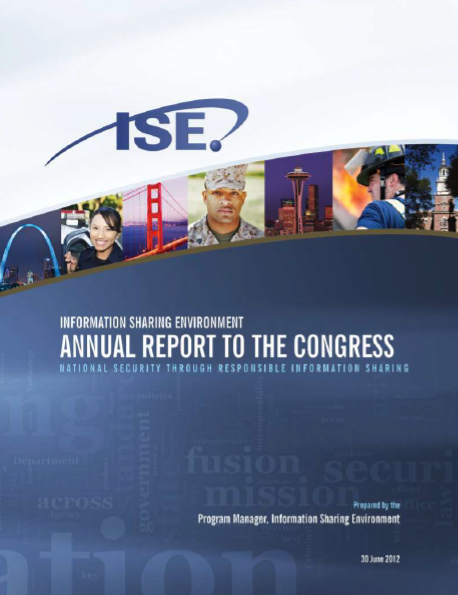Information Sharing Environment Annual Report to the Congress 2012
- 188 pages
- June 30, 2012
- 3.9 MB
Foundational initiatives such as state and major urban area fusion centers, the Nationwide Suspicious Activity Reporting Initiative (NSI), and the Interagency Threat Assessment and Coordination Group (ITACG) continue to mature by expanding their partnerships into new communities, refining technologies and shared services, and working toward performance and mission outcomes. In the law enforcement and intelligence communities, the previous year’s efforts are setting the stage for changes in the potential to move information sharing beyond previous expectations. The expansion of federal agency participation in Joint Terrorism Task Forces dramatically improves communication, coordination, and cooperation, leading to a more efficient and effective response to terrorist threats. Emerging ideas for transforming the public safety information sharing business model, coupled with the use of new technologies, such as facial recognition by frontline officers, are making the vision of eliminating administrative and jurisdictional obstacles to information sharing a reality. And the Intelligence Community’s IT transformation effort will significantly enhance our ability to share and safeguard information, undoubtedly paving the way for shared services implementation by all communities in the ISE.
…
OTHER GAPS, CHALLENGES, AND OPPORTUNITIES
In the process of compiling this Report, and based on our interactions with ISE agencies, PM-ISE identified several additional gaps, challenges, and opportunities for improvement of the ISE. Near-term actions to address these issues are reflected in the high-level roadmap included in the Way Forward section of this Report. The implementation roadmap includes three years of implementation guidance from the PM-ISE to the agencies, based upon the Administration’s priorities. PM-ISE and the ISA IPC will monitor ISE agency efforts to implement this guidance through the governance and performance management actions outlined in Section 6 of this Report. Significant issues to address are as follows:
- The need to Transform Information Sharing Business Models
- Finding: Resource constraints, especially among state, local, and tribal (SLT) law enforcement agencies, necessitate the transformation of information sharing business models. A significant cost savings could be realized through consolidation, regionalization, and reuse of open standards and trusted IT platforms. In addition, as diverse resources are applied to particular justice and public safety problems (including terrorism), systems at all levels of government need to factor in case deconfliction. Development of common, agreed-upon, national deconfliction standards will help ensure common awareness in the operational environment.
- Challenges with Data Aggregation
- Finding: Centralized data correlation and data storage introduces privacy and security challenges that limit mission effectiveness. The development of a data aggregation reference architecture could alleviate these challenges by establishing a roadmap for centralized correlation with decentralized data producers. In addition, unstructured data, such as free-form text documents, presents further technical and human resource challenges.
- Public-Private Sector Information Sharing Gap
- Finding: According to the National Infrastructure Advisory Council (NIAC), federal-private sector bidirectional information sharing is still relatively immature, leaving a large gap in public-private sector information sharing. In particular, intelligence sharing between the Federal Government and private sector owners and operators of critical infrastructure is lagging behind the “marked improvements” the NIAC observed in the sharing of federal intelligence with state, local, tribal, and territorial governments over the last several years.
- Tribal Information Sharing Gaps
- Finding: There are opportunities to increase tribal information sharing through the National Network of Fusion Centers. PM-ISE and its federal partners are focused on addressing and improving some of the foundational policy, governance, relationship, and capacity issues related to tribal information sharing. SLT partners are expanding tribal participation through Fusion Liaison Officer (FLO) programs.
- Classified Information Sharing and Safeguarding Governance Gaps
- Finding: With the collective progress in developing Federal Government-wide governance structures for Secret networks and in solidifying key priorities and milestones for implementation, the Federal Government is positioned for continued improvements in classified information sharing and safeguarding in the coming year.
- Opportunity with Cybersecurity Information Sharing
- Finding: Given the increasing frequency, impact, and sophistication of attacks on information and information systems in the United States, cybersecurity is a national security priority. Cybersecurity can be improved if agencies more effectively share cyber-vulnerability and intrusion incident information. The application of the ISE’s proven information sharing techniques and processes to the cyber information sharing problem set can enable this. As new legislation emerges in this area, information
sharing related to cybersecurity functions will play an increasingly important role in the ISE.- Opportunity to Strengthen Collaboration and Coordination Between Federal, State, Local, Tribal, and Private Sector Entities
- Finding: To further accomplish the goals of the ISE as stated in IRTPA and Presidential Guidelines,10 PM-ISE and its mission partners are exploring new mechanisms for enhancing collaboration and coordination between federal, state, local, tribal, and private sector entities. Although significant information sharing relationships have been institutionalized between these organizations, it is anticipated that a dedicated forum is needed to fully bring the accountability, oversight, and governance capabilities of the ISE to bear on lingering information sharing gaps between federal agencies and non-federal partners by enhancing understanding of one another’s missions, the respective policy and legal hurdles each faces, and the benefits each will realize through senior-level interaction.

